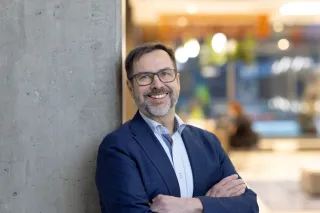VTT develops new manufacturing technologies based on microbially grown substances. Biotechnology has traditionally been used to produce chemicals, biofuels and pharmaceuticals. The latest trend is to make new materials from microbes.
There is a lot of talk about the need to move away from oil-based materials and adopt sustainable solutions to reduce the volume of microplastics in the environment. This led VTT to study how nature makes its own building blocks.
– In nature, microbes have a key role in breaking down biomass while producing various types of biopolymers. Our project focused on biotechnology as a means to use microbes to produce materials that benefit humans, explains VTT's Senior Scientist Géza Szilvay from the Korvaa project, which studied how natural biomaterials can be used in product development.
The end result was a set of headphones made from natural materials.
The groundbreaking headphones still feature conventional electronic components, but the other parts are made from various microbially grown biomaterials.
– The headband is made of biobased and biodegradable PLA plastic, Szilvay says.
VTT has developed a process that uses yeast to convert renewable feedstocks into lactic acid which is then polymerized into PLA.
Help from mycelium
According to Szilvay, the PLA plastic was 3D-printed into shape.
The covering of the headphone ear pads is fungal mycelium, which Szilvay says is a relatively new material, which is remarkably reminiscent of leather. The headphones also feature a fine membrane made of microbially grown silk protein.
– The protein in the biosynthetic silk membrane resembles the proteins found in a spider's web, which we produced by introducing into microbes the spider silk gene responsible for producing the unique silk protein. This allowed us to biosynthetically produce the silk protein and turn it into a nonwoven membrane by electrospinning technology, explains VTT's Research Scientist Pezhman Mohammadi.
Spider silk is a very tough biopolymer and therefore more durable than most oil-based synthetic polymers, he adds.
In the padding itself, a fungal protein was utilized that produces extremely stable foams. This protein foam was used as scaffold for cellulose to make a soft material.
The outermost layer of the headphones consists of a biocomposite that is made from bacterial cellulose and mycelium.
PLA plastic is already commercially available. Recently also spider silk proteins and mycelium based materials are being commercially developed. According to Mohammadi, spider silk has potential uses in both medicine and the industrial sector:
– We are foreseeing spider silk being used in, for example, textiles and surgical fibres.
Promoting circular economies
According to the researchers, the aim of the Korvaa project was to demonstrate the potential of synthetic biology.
– We chose headphones as an example of a product that is not only contemporary and personal but also complex, as there are many different kinds of materials involved, Szilvay explains.
Although the concept has attracted a lot of interest, Szilvay says the headphones are not intended to be produced commercially.
– The fact that many materials can be replaced with biotechnologically produced materials is interesting in itself. Of course we have thought about where to go from here and which biomaterials to further develop for industrial use.
The Korvaa project had a tight schedule: according to Szilvay, the headphones took only about six months to produce. VTT and Aalto University were responsible for producing the materials, Aivan for industrial design, and Fotoni Film for documenting and photographing the project.
Making the materials and turning them into a finished product was fascinating and something that I have not personally done before, Szilvay says.
– It was also new for Aivan to be involved in a project in which the basis of design are materials in research phase. The material characteristics – not the design only – influenced how the product would turn out.
The project and the development of the materials used in the headphones were financed by the Academy of Finland's Centre or Excellence HYBER, Sitra (the Finnish Innovation Fund) and the Jenny and Antti Wihuri Foundation for projects coordinated by Prof. Merja Penttilä, as well by the Synbio Powerhouse ecosystem, VTT, and the Sophie von Julin Foundation.








